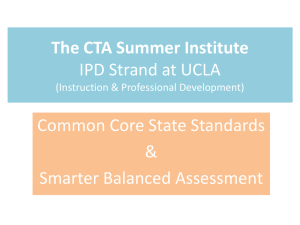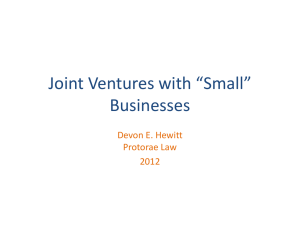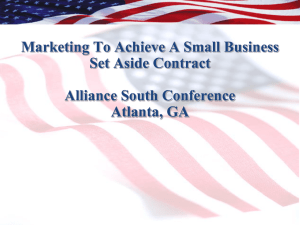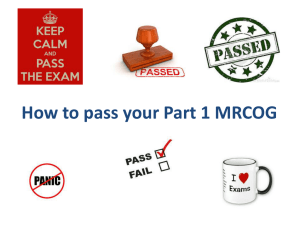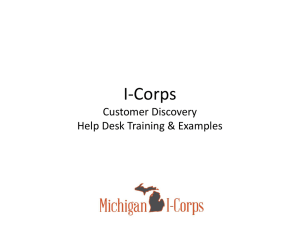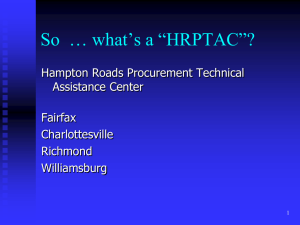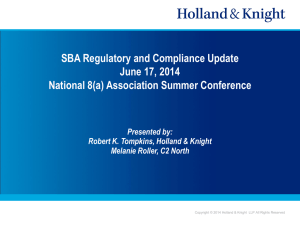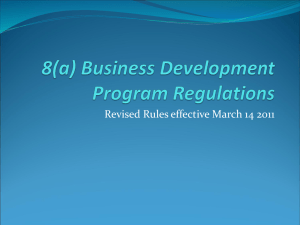things to know about 8a – cdc - Georgia Tech Procurement
advertisement
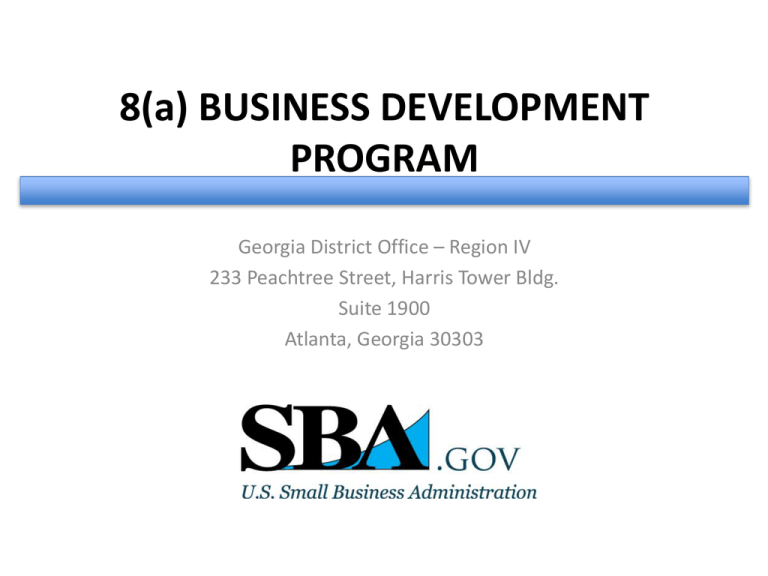
8(a) BUSINESS DEVELOPMENT PROGRAM Georgia District Office – Region IV 233 Peachtree Street, Harris Tower Bldg. Suite 1900 Atlanta, Georgia 30303 GEORGIA DISTRICT OFFICE 8(a) Division • Office Telephone • Carolyn Griffin, Supervisory Business Opportunity Specialist x501 • Uneeda Collins, Business Opportunity Specialist x502 • JoAnn Braxton, Business Opportunity Specialist x505 • Paula Watts, Business Opportunity Specialist x506 • Tanzee Hall-Jones, Business Opportunity Specialist x507 • Brian Murden, Business Opportunity Specialist x509 • Lillian Martin, Business Opportunity Specialist x703 (404) 331-0100 8(a) Eligibility • Objective: “to promote the business development of small business concerns owned and controlled by socially and economically disadvantaged individuals…..to promote the competitive viability of such concerns and to clarify and expand the program for procurement by the United States. • Term – 9yrs. Years 1-4 = Developmental / Years 5-9 = Transitional Stage Continuation in the program is dependent on the firm’s continuing eligibility as a socially and economically disadvantaged owned/operated firm and continued compliance with the 8(a)BD participation agreement. Disadvantaged (with different thresholds), Unconditionally Owned, Controlled and Managed by disadvantage individual(s), Small, U.S. Citizen, Good Character • Social Disadvantage – preponderance of evidence • • • • • Black American Asian Pacific American Hispanic American (includes individuals of Spanish & Portuguese descent). Native American Subcontinent Asian American • Economic Disadvantage • • • (Net Worth, Personal Income, Total Assets) Net worth - After excluding the individual’s equity in the firm and equity in the primary residence, net worth may not exceed: $250,000 for 8(a) OR $750,000 for Continuing Eligibility Personal Income cannot exceed an average of $250,000 over the previous three years and $350,000 for continuing eligibility Total Assets cannot exceed $4 million and $6 million for continuing eligibility CONTINUATION At least 51% unconditional ownership by the disadvantaged individual(s). Upon entrance into program, applicant must be small based on its primary NAICS Code, including affiliates. Size is determined either by: average 3 years revenues OR # of employees Proof of two years operation in the firm’s primary industry as verified by revenues reported in business tax returns. SBA will consider those who meet WAIVER RULE requirements. Ineligible businesses: brokers * ; debarred or suspended persons or concerns; nonprofit organizations. Franchises may be allowed contingent upon SBA review of the franchise agreement. Change of ownership must be approved by SBA CONTINUATION § 121.101 What are SBA size standards? SBA's size standards define whether a business entity is small and, thus, eligible for Government programs and preferences reserved for “small business” concerns. In order for a concern to remain eligible for 8(a) BD program participation, it must continue to meet all eligibility criteria contained in § 124.101 through § 124.108. Any concern that fails to meet the eligibility requirements after being admitted to the program will be subject to termination or early graduation under §§ 124.302 through 124.304, as appropriate. § 121.601 What is a small business for purposes of admission to SBA's 8(a) Business Development program? An applicant must not exceed the size standard corresponding to its primary industry classification in order to qualify for admission to SBA's 8(a) Business Development Program. CONTINUATION § 124.2 What length of time may a business participate in the 8(a) BD program? • A Participant receives a program term of nine years from the date of SBA's approval letter certifying the concern's admission to the program. The Participant must maintain its program eligibility during its tenure in the program and must inform SBA of any changes that would adversely affect its program eligibility. The nine year program term may be shortened only by termination, early graduation (including voluntary early graduation) or voluntary withdrawal as provided for in this subpart. Contract awards can be made up eligible firm’s graduation date. Options must be priced and all signatures are applicable to this date. HOW CAN A BUSINESS CAN LEAVE THE 8(a) BD PROGRAM? 124.301 A concern participating in the 8(a) BD program may leave the program by any of the following means: • • • • (a) Expiration of the program term established pursuant to § 124.2; (b) Voluntary withdrawal or voluntary early graduation; (c) Graduation pursuant to § 124.302; (d) Early graduation pursuant to the provisions of §§ 124.302 and 124.304; • (e) Termination pursuant to the provisions of §§ 124.303 and 124.304 • No Longer Small SOLE-SOURCE THRESHOLDS § 124.506 At what dollar threshold must an 8(a) procurement be competed among eligible Participants? • Simplified Acquisition Procedures – purchase less than $150,000 • Sole Source – purchase greater than $150,000 but not to exceed $6,500,000 for manufacturing and $4,000,000 for all others • Competitive thresholds. (1) The Federal Acquisition Regulatory Council (FAR Council) has the responsibility of adjusting each acquisitionrelated dollar threshold on October 1, of each year that is evenly divisible by five. • The anticipated award price of the contract, including options, will exceed $6,500,000 for contracts assigned manufacturing NAICS codes and $4,000,000 for all other contracts. NAICS CODES • 13 CFR Section 121.201 provides a full table of small business size standards matched to the U.S. NAICS industry codes. A full table matching a size standard with each NAICS Industry or U.S. Industry code is also published annually by SBA in the Federal Register. How Does SBA Verify a North American Industrial Classification System (NAICS) code Assigned to the Requirement? • As part of the acceptance process, SBA will verify the appropriateness of the NAICS code assigned by the procuring activity. In general, SBA will accept the NAICS code assigned as long as it is reasonable, even though other NAICS codes may also be reasonable. If SBA and the procuring activity disagree over the NAICS code assigned, the District Office should make every effort to resolve the matter through discussion with the procuring activity. CONTINUATION • If negotiations fail, SBA may reject the requirement, appeal the designation to the head of the procuring agency pursuant to 13 CFR 124.505, or appeal the NAICS code assigned to the Office of Hearings and Appeals (OHA): See 13 CFR l24.503(b). Reminder: Request for eligibility review is required prior to award of contract to lowest bidder on a competitive 8(a) set-aside. SUBCONTRACTING • Through the Partnership Agreement SBA delegates to the US Department of Defense SBA contract execution functions. The Procuring Activity shall adhere to contractual assistance and retains responsibility for compliance with the limitations on subcontracting requirement and all applicable provisions of FAR 52.219-14 52.219-14 -- Limitations on Subcontracting (Nov 2011) • This clause does not apply to the unrestricted portion of a partial set-aside. • (b) Applicability. This clause applies only to-- CONTINUATION • (1) Contracts that have been set aside or reserved for small business concerns or 8(a) concerns; • (2) Part or parts of a multiple-award contract that have been set aside for small business concerns or 8(a) concerns; and • (3) Orders set aside for small business or 8(a) concerns under multiple-award contracts as described in 8.405-5 and 16.505(b)(2)(i)(F). • (c) By submission of an offer and execution of a contract, the Offeror/Contractor agrees that in performance of the contract in the case of a contract for – • (1) Services (except construction). At least 50 percent of the cost of contract performance incurred for personnel shall be expended for employees of the concern. CONTINUATION • (2) Supplies (other than procurement from a non-manufacturer of such supplies). The concern shall perform work for at least 50 percent of the cost of manufacturing the supplies, not including the cost of materials. • (3) General construction. The concern will perform at least 15 percent of the cost of the contract, not including the cost of materials, with its own employees. • (4) Construction by special trade contractors. The concern will perform at least 25 percent of the cost of the contract, not including the cost of materials, with its own employees. Performance Problems First point of contact for 8(a) contract performance concerns is the SBA Servicing Office and the Business Opportunity Specialist assigned to that business. 8(a) JOINT VENTURES • 13 CFR 124.513 and SBA’s Standard Operating Procedures (SOPs) 80 05 3, Chapter 8 governs 8(a) Joint Venture a) General - If approved by SBA, a Participant may enter into a joint venture agreement with one or more other small business concerns, whether or not 8(a). *Mentor(s) are included in this regard • (1) Participants, for the purpose of performing one or more specific 8(a) contracts. • (2) A joint venture agreement is permissible only where an 8(a) concern lacks the necessary capacity to perform the contract on its own, and the agreement is fair and equitable and will be of substantial benefit to the 8(a) concern. CONTINUATION (b) Size of concerns to an 8(a) joint venture. • (1) A joint venture of at least one 8(a) Participant and one or more other business concerns may submit an offer as a small business for a competitive 8(a) procurement so long as each concern is small under the size standard corresponding to the NAICS code assigned to the contract • (2) For sole source and competitive 8(a) procurements that do not exceed the dollar thresholds - The combined annual receipts or employees of the concerns entering into the joint venture must meet the size standard for the NAICS code assigned to the 8(a) contract (c) Performance of work - For any 8(a) contract, including those between mentors and protégés authorized by § 124.520, the joint venture must perform the applicable percentage of work required by § 124.510. SBA’s MENTOR PROTÉGÉ PROGRAM 13 CFR 124.520 The Mentor Protégé Program is designed to encourage approved mentors to provide various forms of business development assistance to protégé firms. • • • • • A) Management B) Technical C) Financial in the form of equity investment and/or loans D) Subcontracts, Joint Venture Arrangements D) Bonding • Mentors are encouraged to provide assistance relating to the performance of non-8(a) contracts so that protégé firms may more fully develop their capabilities. • Purpose of the program is relationship is to enhance the capabilities of the protégé, assist with meeting goals in business plan, and improve ability to successfully compete for contracts. CONTINUATION • Mentor • • • • • • • i) Commitment / ability to assist developing of Protégé ii) Good Character iii) Favorable Financial Health iv) Not Debarred or Suspended on Federal List v) Impart Value by Lessons Learned and Experience vi) One Protégé unless otherwise approved by SBA vii) Annual Certification CONTINUATION • Protege • i) Developmental Stage or no 8(a) contracts • ii) Size – less than half the size standard corresponding its primary NAICS • iii) Good Standing • iv) One Protégé unless approved by SBA • v) Cannot become Mentor while being a Protégé • vi) Yearly approval for another year of participation • vii) At least 6 months remaining in 8(a) BD Program REMAINING 2013 UPCOMING 8(a) WORKSHOPS SBA Georgia District Office – 10:00a.m. – noon May 8 June 12 July 10 August 14 September 11 October 9 November 13 December 11 Registration – Required at www.sba.gov – TRAININGS / WORKSHOPS
